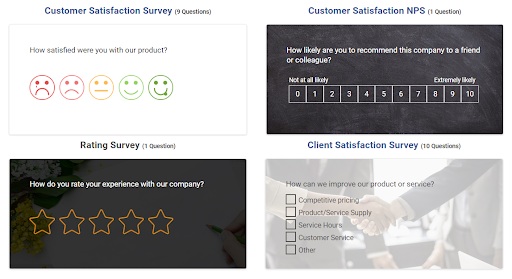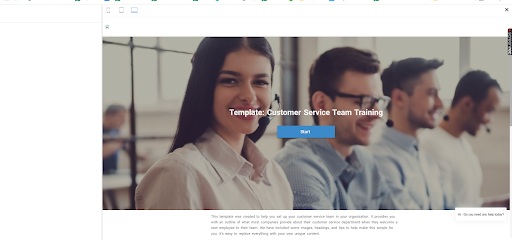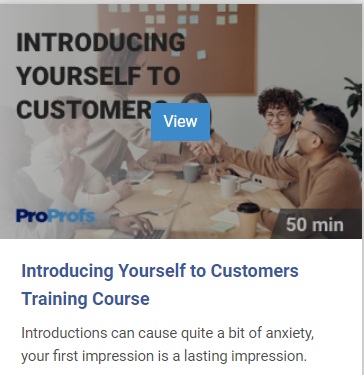Customer service training is worth every penny. This is because apart from a company’s specialty products, the success story of all businesses is woven around excellent customer service.
Let these numbers do the talking:
- 70% of customers’ buying experiences are influenced by how they feel they are being treated. (McKinsey)
- A customer is 4x more likely to buy from a competitor if the problem is service-related rather than price or product-related. (Bain & Company)
- It takes 12 positive customer experiences to compensate for one negative experience. (Ruby Newell-Legner, customer satisfaction specialist)
These statistics reinforce the fact that customer service is a critical factor in any business, irrespective of the industry. It can make or unmake a business. Delightful customer service is the name of the game.
The way your customer care agents communicate with your customers, handle customer complaints, and the response time – all boil down to training. And for customer service teams to be good at what they do, they need the right customer service training.
This is what this blog post is going to discuss. You will learn what customer service training is, why it’s important, training types, the best courses, and how a learning management system (LMS) can help you.
Continue reading to find out.
What Is Customer Service Training?

Customer service training is a training program for customer support teams to improve the quality of customer service. The ultimate goal of this training is to educate customer service teams on how to ensure customer satisfaction, customer retention, and customer success.
Like other training programs, customer care training has gone online in recent years. This is clearly because of some significant advantages that you don’t find in traditional learning systems.
Online customer service training offers flexibility to learn anytime, anywhere, and on any device. Learners can choose their schedules and self-pace the training.
Instructors, on their part, can easily create training modules, share them with an audience, locally or remotely, and track progress in real-time.
Watch this video to learn how to offer faster, better, and more efficient customer service through automation:
Types of Customer Service Training
Depending on who you train, when, and how, this training can fall into different categories. Some of the common ones are:
- New Hire Training
This customer service training is for new hires, both new and experienced. During the training, they learn how to work with new products, services, and client bases.
In this sense, it’s an onboarding training program that acclimatizes new hires to a new work environment, company culture, products and services, and customers.
The newly hired customer service representatives also get acquainted with existing team members and office premises. It’s also when you set up the workspaces and tools and communicate the job expectations.
- Quarterly or Yearly Training
Targeted at existing employees, this type of training is conducted at regular intervals. You may choose a schedule based on what works best for you and your teams.
Employees generally undergo training on skills and competencies based on evolving industry trends to keep pace with them.
Similarly, team-building activities form a key part of this training type since customer support works in teams and they need to maintain strong relationships.
- In-House Training: In-house training is a cost-effective and time-saving method of educating customer service executives. It uses one’s own trainers and training materials to conduct training internally in the workplace and doesn’t involve traveling.
The training program may be classroom-based, online, or blended.
- Outside Consultation: Sometimes, companies take the service of external expertise. Since subject-matter experts conduct the training, the programs are usually inspiring and reliable.
Customer service teams may attend the expert sessions online, or they may physically attend seminars to improve their trade skills.
- Need-Based Training: This is the most unique of all training types discussed so far.
At times, there may be a new product launch, rebranding, recall, or a large-scale ad campaign. In such a situation, you need to train your customer service agents in conjunction with these special events.
Such time-sensitive training prepares employees to take calls, field questions, respond to emails, and handle inquiries about your brand activity.
Business Benefits of Customer Service Training
“The best advertising is done by satisfied customers.” – Philip Kotler, Marketing Consultant
Customer service can and should never be an afterthought. On the contrary, it’s the factor that decides whether a customer wants to stick around with a business or not.
Excellent customer service can put your business at a competitive advantage.
Deploying customer service training for employees can:
- Build knowledge, skills, and the confidence to deal with customers
- Equip your employees with in-depth product and service knowledge
- Improve the quality of customer service
- Ensure customers get the best treatment possible from your employees
- Promote positive customer experiences consistently from a trained team
- Improve employee productivity, job satisfaction, and retention
- Increase customer motivation, happiness, loyalty, and retention
- Attract new customers through word of mouth
Remember, when you invest in your customer service teams, you invest in your customers. It’s about turning your customer service into a growth engine.
Top Customer Service Skills to Develop

Since we’re talking about customer service training, let’s also understand some of the in-demand skills expected of a professional. This will enable you to provide relevant training to your employees.
Most of these are soft skills or people’s skills and you should focus on them as the objectives of customer service training.
- Communication Skills
Communication skills, whether verbal or written, can help customer service teams build lasting relationships with customers. When there’s clear communication, they can understand each other better.
Similarly, positive and transparent communication builds trust with customers. Employees should continuously improve their communication skills to avoid miscommunication, objections, and conflicts.
View This Course View All Communication Courses
- Listening Skills
“Everybody talks, nobody listens. Good listeners are as rare as white crows.” — Helen Keller
Like communication skills, listening skills enable you to understand your customers’ needs better. Customer service representatives with active listening skills know what their customers say and why. They can make out the mental state of the customers from the tone or inflection of their voice.
Not only this, the representatives can respond to clients appropriately only if they’re good at listening.
- Empathy
Empathy is that component in customer service that lets you understand why a customer approached you in the first place. Empathetic employees and especially customer service agents make customers feel understood & valued and such customers tend to return.
It’s about readily realizing customers’ pain points.
As inspirational speaker Simon Sinek says:
“Customer service isn’t about the customer always being right, it’s about the customer feeling heard. If we truly serve our customers with respect, we’ll cultivate loyalty that lasts.”
Ensuring service reps understand this concept can involve conducting training programs where they are taught the following:
- Ensure interactions are conversational instead of transactional
- Have more personalized interactions
- Try to see things from the perspective of customers
- Emphasis on principles rather than just procedures
- The art of not taking the customers’ words personally
- Patience
This skill finds usage when you’re dealing with difficult customers. It’s the ability to understand the point they are trying to make without losing your cool.
Customer service teams should show the courage to keep listening and focusing on their customers regardless of how unhappy, frustrated, or angry the customers are. In the end, they will earn respect from their customers for bearing with them. - Time Management
No matter how highly you think of your customers and what amazing customer service ideas you have for them, you won’t be able to deliver on them if you are not great at managing time.
That’s why you need to cultivate time management skills. This will make you more efficient, productive, and dependable.
- Customer Advocacy
It’s a specialized skill for putting customers’ interests first before anything else. Employees with this skill know what their customers need and how best to meet them.
They are relentless in their focus and in meeting customers’ real needs without cutting corners.
You can train your employees on this skill by using customer advocacy strategies.
How to Create a Customer Service Training Program
A discussion on customer service skills training will remain incomplete without a section on how to develop such a program.
Proper planning, execution, and evaluation form the three pillars of successful customer service training programs. Let’s elaborate on each of them.
- Planning
Before you conceive your customer service training plan, you should know your customers well. You need to know:
- how they perceive you,
- what they expect from your brand, and
- how you can connect with them best.
Here, customer surveys can give you the necessary analytics to gain a deeper understanding of your customers. They can help you shape your training according to the feedback they shared.

View Customer Service Survey Templates
Along with this, you should analyze how you’re delivering as a team and as an organization, as well as if there are any shortcomings. Identify the current knowledge and skill level of your customer support team, their training needs, if any, and resources available.
- Execution
When administering customer service training or any other employee training, choosing a proven method is crucial.
For example, you can apply the 70/20/10 model. According to it, people tend to acquire 70% of their knowledge from experiences, 20% from social learning, and 10% from formal training.
This means you need to use a mixed learning delivery model based on that ratio.
As you can see, the emphasis should be on experiential learning or learning by doing. For this, you can put learners under real job scenarios and let them learn by actually performing a task.
Similarly, you can share case studies and simulations to explain how things work in reality.
- Evaluation

Regular evaluation and feedback, both during and after training, can give your customer service training a sense of direction. These assessments will shed light on who is progressing as expected, who is falling behind, and who needs extra assistance.
Similarly, an analysis of training data will reveal the overall experience of your learners, difficulty areas, and even satisfaction level.
You should also look at how completing the customer service program has impacted your client servicing.
Based on the results you see on the ground, you can give specific and actionable feedback to training participants.
What Should Be Included in Customer Service Training
Generally, these training programs primarily focus on enhancing the knowledge and skills of customer service professionals to perform their job roles in the best way. Due to this, mastering customer service skills like the ones we discussed above will be an integral part of the training.
That said, the best customer service training may also cover some other areas.
For example, you may add a session on your company’s mission and vision. Customer service agents serve as a point of contact for customers. They also act as your business representatives. That’s why they should resonate with your brand’s values during their interactions with customers.
A self-care program is another topic you can include in the training. Customer service agents are often under a lot of pressure, having to deal with difficult customers and their complex problems.
So, you can encourage them to add healthy practices like yoga, meditation, and physical exercises to their routine. You can offer free gym memberships as a gesture that you care about their well-being.

To get a better idea of what can be a part of such courses, view this Customer Service Training Template.
Top Customer Service Training Courses
Choosing the right customer service training courses for your employees is half the work done. It will help them acquire the required knowledge and skills the right way.
Make sure the courses you choose are designed by industry experts, up-to-date, and customizable with your company policies and branding.
Here are some such courses that might be helpful:
- Introducing Yourself to Customers

For customer-facing employees, making a lasting first impression is vital. It sets the tone for lasting business relationships. This course will help you introduce yourself to your customers with confidence and a positive attitude, and gradually build trust. It discusses both face-to-face and written introductions.
Writing Customer Service Emails

Emails are one of the most widely used mediums of business communication. For many companies, they are the primary mode of communicating with customers. You can deploy this course to train your customer support teams on email etiquette. Compose simple, clear, and empathic written correspondence and build trust and loyalty with your customers.
Managing Customer Expectations

Understanding and meeting customers’ expectations is a priority for every customer service department. Identify and manage their expectations so you can live up to them consistently. This online training course walks you through the art of managing customer expectations. You can set your product & service standards and delight your customers by meeting them.
How to be Likable
A likable personality is an important trait in customer service professionals. To come across as a likable person is critical when dealing with customers.
This online course offers tips on becoming more likable, including active listening and authenticity, and you can use it to train your employees on the importance of politeness and respectfulness.
Now that you know what your training program can look like, it’s time to discover the right way to conduct it. With the era of physical classroom training phasing out, you’ll need to know how online customer service training can help you.
How Can an LMS Help With Customer Service Training?
LMS software can serve as a reliable online customer service training tool. Such solutions are a big game-changer in helping streamline online learning & development and making it sustainable in the long run. They make an essential tool to plan, create, share, and track customer service training courses and tests online.
Using such online training software, you can easily create online courses and train your customer support team on core customer service skills.
For example, you can create a course on effective telephone skills to help develop communication skills of your customer service representatives. You can tie this training to your ultimate business goal of increased sales.
If you are short on time, you can upload your existing content such as docs, videos, presentations, and PDF files, and put together a professional-looking course quickly.
One of the best parts of these employee training systems is you can easily customize your courses and quizzes, add personalized learning paths, share them via multiple channels, and track progress and completion in real-time.
Some of the enabling features in an LMS for customer service training are:
- Integrated Course Authoring Tool
- Course Library
- Virtual Classroom Software
- Discussion & Collaboration
- Quizzes & Surveys
- Reporting
Their versatile nature enables users to deploy all kinds of corporate training programs, including compliance, safety, policy & procedure, and core employee skills.
This way, learning management systems can help you turn your customer service training ideas into reality easily and effectively.
Get Free Employee Training Software — All Features, Forever.
We've helped 567 companies train 200,000+ employees. Create courses in under a minute with our AI LMS or use 200+ ready-made courses on compliance, harassment, DEI, onboarding, and more!
Ensure Customer Success With Customer Service Training
Customers come with high hopes when they touch base with a customer service department. They share their experiences with a company’s products and services, their pain points, and seek answers to some pressing questions.
To provide excellent customer service and keep your customers happy, you need to have what it takes.
Training your customer service teams through a well-developed online employee training program is the surest way to achieve this goal. For that, you need to:
- develop a training plan
- use the right tools & courses
- train your employees on core skills
- evaluate training results
All this translates into quality customer service, customer delight, customer loyalty, and business profits. All you need is the right approach and resources, including the right tools to deploy the training program successfully.
 Tips
Tips
We’d love to hear your tips & suggestions on this article!
Get Free Employee Training Software — All Features, Forever.
We've helped 567 companies train 200,000+ employees. Create courses in under a minute with our AI LMS or use 200+ ready-made courses on compliance, harassment, DEI, onboarding, and more!

 We'd love your feedback!
We'd love your feedback! Thanks for your feedback!
Thanks for your feedback!







